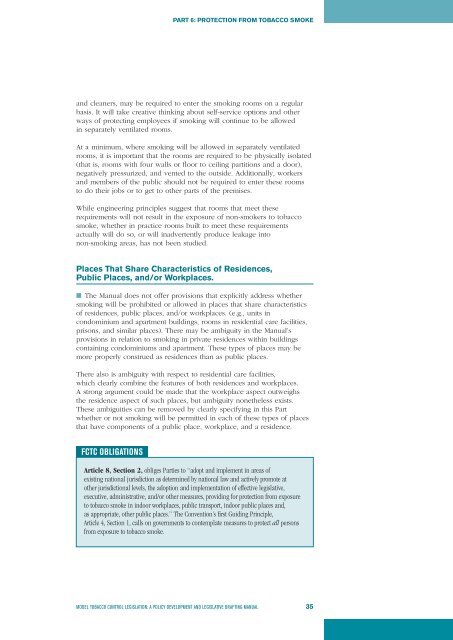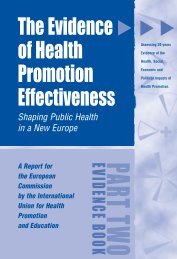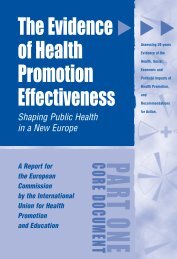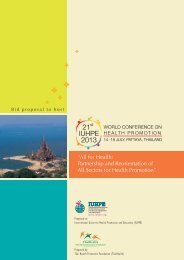Model Legislation for Tobacco Control: A policy development
Model Legislation for Tobacco Control: A policy development
Model Legislation for Tobacco Control: A policy development
You also want an ePaper? Increase the reach of your titles
YUMPU automatically turns print PDFs into web optimized ePapers that Google loves.
and cleaners, may be required to enter the smoking rooms on a regular<br />
basis. It will take creative thinking about self-service options and other<br />
ways of protecting employees if smoking will continue to be allowed<br />
in separately ventilated rooms.<br />
At a minimum, where smoking will be allowed in separately ventilated<br />
rooms, it is important that the rooms are required to be physically isolated<br />
(that is, rooms with four walls or floor to ceiling partitions and a door),<br />
negatively pressurized, and vented to the outside. Additionally, workers<br />
and members of the public should not be required to enter these rooms<br />
to do their jobs or to get to other parts of the premises.<br />
While engineering principles suggest that rooms that meet these<br />
requirements will not result in the exposure of non-smokers to tobacco<br />
smoke, whether in practice rooms built to meet these requirements<br />
actually will do so, or will inadvertently produce leakage into<br />
non-smoking areas, has not been studied.<br />
Places That Share Characteristics of Residences,<br />
Public Places, and/or Workplaces.<br />
■ The Manual does not offer provisions that explicitly address whether<br />
smoking will be prohibited or allowed in places that share characteristics<br />
of residences, public places, and/or workplaces. (e.g., units in<br />
condominium and apartment buildings, rooms in residential care facilities,<br />
prisons, and similar places). There may be ambiguity in the Manual’s<br />
provisions in relation to smoking in private residences within buildings<br />
containing condominiums and apartment. These types of places may be<br />
more properly construed as residences than as public places.<br />
There also is ambiguity with respect to residential care facilities,<br />
which clearly combine the features of both residences and workplaces.<br />
A strong argument could be made that the workplace aspect outweighs<br />
the residence aspect of such places, but ambiguity nonetheless exists.<br />
These ambiguities can be removed by clearly specifying in this Part<br />
whether or not smoking will be permitted in each of these types of places<br />
that have components of a public place, workplace, and a residence.<br />
FCTC OBLIGATIONS<br />
PART 6: PROTECTION FROM TOBACCO SMOKE<br />
Article 8, Section 2, obliges Parties to “adopt and implement in areas of<br />
existing national jurisdiction as determined by national law and actively promote at<br />
other jurisdictional levels, the adoption and implementation of effective legislative,<br />
executive, administrative, and/or other measures, providing <strong>for</strong> protection from exposure<br />
to tobacco smoke in indoor workplaces, public transport, indoor public places and,<br />
as appropriate, other public places.” The Convention’s first Guiding Principle,<br />
Article 4, Section 1, calls on governments to contemplate measures to protect all persons<br />
from exposure to tobacco smoke.<br />
MODEL TOBACCO CONTROL LEGISLATION: A POLICY DEVELOPMENT AND LEGISLATIVE DRAFTING MANUAL 35






